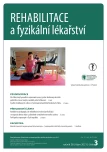The use of meridian exercises in physiotherapy of non-specific back pain
Authors:
Žiaková E. 1; Jančová D. 2; Sládeková N. 1; Musilová E. 3; Ištoňová M. 4
Authors‘ workplace:
Katedra Fyzioterapie, Fakulta ošetrovateľstva a zdravotníckych odborných štúdií, Slovenská zdravotnícka univerzita v Bratislave, Slovenská republika
1; Katedra fyzioterapie, Fakulta zdravotníckych vied, Univerzita sv. Cyrila a Metoda v Trnave, Slovenská republika
2; Katedra biologických a lekárskych vied, Fakulta telesnej výchovy a športu, Univerzita Komenského v Bratislave, Slovenská republika
3; Klinika fyziatrie, balneológie a liečebnej rehabilitácie, Lekárska fakulta, Univerzita Pavla Jozefa Šafárika v Košiciach, Slovenská republika
4
Published in:
Rehabil. fyz. Lék., 28, 2021, No. 3, pp. 109-124.
Category:
Original Papers
doi:
https://doi.org/10.48095/ccrhfl2021109
Overview
This paper deals with the theory of tendon-muscle pathways of Traditional Chinese Medicine and the use of meridian exercises in physiotherapy. On a deliberately selected sample of 30 probands aged 19 to 55 years meeting the set criteria, the effect of exercises is determined for non-specific pain in the cervical, thoracic and lumbar spine. The pilot prospective study compares the intensity of the pain in individual areas of the back before the start of a 4-week exercise cycle at least 3 times a week and after the end of the exercise cycle. After a series of meridian exercises, there was a statistically significant reduction in pain in the cervical spine M 0.67; P = 0.04; in the area of the thoracic spine M 1.03; P = 0.02 and at the level M 1.03; P = 0.001 in the area of the lumbar spine. The frequency of pain during the week decreased on average by 0.93, P = 0.00. The pilot study clearly confirmed the positive effect of meridian exercises on reducing the intensity of pain in individual areas of the back and on reducing the frequency of perceived pain. The elaborated topic has the perspective of elaboration in the level of physiotherapeutic procedures and their use for various diagnoses or from the point of view of traditional Chinese medicine and the influence of meridian exercises on individual elements, i.e. organ systems.
Keywords:
back pain – Traditional Chinese medicine – rehabilitation
Sources
- Andersson GB. Epidemiologic features of chronic low-back pain. Lancet 1999; 354(9178): 581–585. doi: 10.1016/S0140-6736(99)01312-4.
- Koes BW, van Tulder MW, Thomas S. Diagnosis and treatment of low back pain. BMJ 2006; 332(7555): 430–434. doi: 10.1136/bmj.332.7555.1430.
- van Tulder M, Becker A, Bekkering T et al. European guidelines for the management of acute nonspecific low back pain in primary care. Eur Spine J 2006; 15 (Suppl 2): S169–S191. doi: 10.1007/s00586-006-1071-2.
- Nachemson AL, Jonsson E. Neck and back pain. Philadephia: Lippincott Williams and Wilkins 2000.
- Repková A. Psychofyzická príprava na pôrod. Bratislava. SZU 2008. ISBN 978-80-89352-21-0.
- Manek NJ, MacGregor AJ. Epidemiology of
- back disorders: prevalence, risk factors and prognosis. Curr Opin Rheumatol 2005; 17(2): 134–140.
- doi: 10.1097/01.bor.0000154215.08986.06.
- Meng A. Tradiční čínská lečebná masáž. 6.vyd. Olomouc: Fontána 2015. ISBN 978-80-
- 7336-781-7.
- Ando V. Klasická čínská medicína. 6. vyd. Brno: Svítaní 2014.
- Kombercová J, Svobodová M. Autorehabilitační sestava. Olomouc: Fontána 2000. ISBN 80-901989-9-6.
- Homzová K. Cvičenie na prebudenie meridiánov. [online]. Dostupné z: https://diochi.sk/cvicenie-na-prebudenie-meridianov/.
- Chengnan S. Čínské léčebné masáže. Hradec Králové: Svítání 2007. ISBN 978-80-86198-45-3.
- Janíková D. Fyzioterapia: funkčná diagnostika lokomočného systému I. 1. vyd. Martin: Osveta 1998. ISBN 80-8063-015-1.
- Kolář P et al. Rehabilitace v klinické praxi. Praha: Galén 2012. ISBN 978-80-7262-657-1.
- Skála B. Léčba bolestí zad. 2017. [online]. Dostupné z: http://slideplayer.cz/slide/7347838/.
Labels
Physiotherapist, university degree Rehabilitation Sports medicineArticle was published in
Rehabilitation & Physical Medicine

2021 Issue 3
Most read in this issue
- Profile of the profession of occupational therapy in the Czech Republic
- Bilateral, traumatic rupture of the quadriceps tendon – a physiotherapeutic pitfall and case report
- The use of meridian exercises in physiotherapy of non-specific back pain
- Influence of the Träbert current on the autonomic nervous system, evaluated by parameters of time and spectral analysis of heart rate variability in healthy probands
